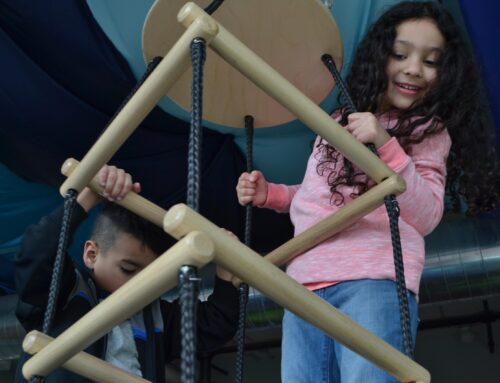If you think back to your days of fun on the playground during elementary school recess, what is one rule that really sticks out in your mind? No climbing up the slide! The rule certainly makes sense to avoid collisions between kiddos. It’s important for children to learn patience and practice turn-taking too. However, did you ever visit the playground after school or on a weekend when there were no teachers present to enforce the no slide climbing rule? Do you remember the exhilaration you felt when finally reaching the top of the slide after multiple attempts, like you’d just conquered Mount Everest? While it’s not quite the same, climbing up a slide is a challenging and fun activity that engages the whole body! Here are some of the benefits:
- Core Strengthening: The abdominal muscles, back muscles and the muscles around the pelvis are put to work. Core strength is the foundation to perform essentially all gross and fine motor movements.
- Upper body strengthening: Biceps, triceps, deltoids, not to mention all of the muscles that stabilize the shoulders. Also, what better way to work on grip strength?
- Lower body strengthening: Quads, glutes, hamstrings, calves, intrinsic muscles of the feet – just to name a few of those lower body muscles getting a work out!
- Proprioception: Talk about heavy work! Pulling one’s body up a slide provides lots of proprioceptive input (sense of body awareness) through the hands and feet.
- Bilateral coordination and motor planning: Both sides of the brain need to communicate to coordinate the movements necessary to climb using a reciprocal pattern. You need to stabilize yourself with one foot/hand while motor planning the next necessary movement.
- Balance: When you’ve FINALLY reached to top of the slide, of course the next step is to slide down! Sliding helps develop the vestibular system, therefore your sense of balance.
Safety tips:
- Create rules for slide climbing, such as: “We can only climb up the slide when mom or dad are with us and say it’s ok.”
- An adult should always be present and close by.
- For school age children, explain that they still need to follow the playground rules and listen to teachers during recess.
- Toddlers should only use slides meant for their size. An adult should be close enough to have the ability to keep hands on small children.
Climbing to the top of the slide isn’t easy – it takes strength, endurance, and determination! Be your kiddo’s cheerleader and provide lots of words of encouragement. Physical benefits aside, the best part of this activity might just be the huge smile on their face when they reach the top!

Blue Bird Day fosters socialization, sensory regulation, and pre-academic learning in children ages 2-7 years in therapeutic rotations that simulate preschool and kindergarten settings. Our compassionate therapists practice a relationship-based and family-centered approach, provide parent training, and collaborate on goals and individualized intensive treatment plans for your child.
We believe in a collaborative and multi-disciplinary team approach to therapy. A team of occupational therapists, speech-language pathologists, dietitians, developmental therapists, behavioral therapists, physical therapists, and therapeutic assistants are created for each child to ensure child and family are fully supported and the best possible results are achieved.
Options for individualized, group and virtual therapy sessions are available as well.
Want to learn more or you have a specific question? Feel free to connect with us here!



